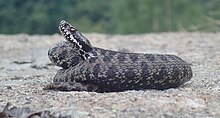Vipera walser
| Vipera walser | |
|---|---|

| |
| Scientific classification | |
| Domain: | Eukaryota |
| Kingdom: | Animalia |
| Phylum: | Chordata |
| Class: | Reptilia |
| Order: | Squamata |
| Suborder: | Serpentes |
| Family: | Viperidae |
| Genus: | Vipera |
| Species: | V. walser
|
| Binomial name | |
| Vipera walser Ghielmi, Menegon, Marsden, Laddaga & Ursenbacher 2016
| |
Vipera walser, the Walser viper or Piedmont viper is a viper endemic to the western Italian Alps. While long considered as an isolated population of Vipera berus, molecular analyses have shown it to be a distinct species related to the Vipera ursinii-complex.[1][2]
Morphology
Morphologically, Vipera walser closely resembles the far more widespread Vipera berus. It differs in having a higher number of cephalic scales and more frequently shows fragmentation of the cephalic large shields. Additionally, most individuals possess 1.5 to 2 rows of subocular scales at both sides of the head, while Vipera berus usually only has a single row. Colouration is highly variable, with some specimens possessing a typical dorsal zigzag pattern, and others with a reduced pattern of horizontal bars.[1] Additionally, melanistic individuals exist.
Geographic range
Vipera walser is limited to a small area north of the Italian town of Biella.[1] The range is divided in a northern population of ±45 km² and a southern population of ±225 km².[3]
Ecology
Vipera walser occurs in open habitats at an altitude of 1300-2300 m in valleys with high precipitation. It is mostly found on gentle south-oriented slopes with low forest cover.[3]
Threats and conservation
Due to its recent description, Vipera walser has not yet been evaluated by IUCN, although the original species description argues that the limited extent of occurrence (<1000 km²) warrants a classification as 'endangered'.[1] Fragmented habitat, decline in agropastoral landuse, culling and collection pose short-term threats, while in the long term climate change may alter the distribution. Additionally, low genetic variability may make the species even more prone to disturbances.[1]
References
- ^ a b c d e Ghielmi, Samuele; Menegon, Michele; Marsden, Stuart J.; Laddaga, Lorenzo; Ursenbacher, Sylvain (2016). "A new vertebrate for Europe: the discovery of a range-restricted relict viper in the western Italian Alps". Journal of Zoological Systematics and Evolutionary Research. 54 (3): 161–173. doi:10.1111/jzs.12138. S2CID 88740081.
- ^ Speybroeck, Jeroen (2016). Field guide to the amphibians & reptiles of Britain and Europe. Wouter Beukema, Bobby Bok, Jan Van der Voort, Ilian Velikov. London. ISBN 978-1-4729-3533-5. OCLC 889164386.
{{cite book}}: CS1 maint: location missing publisher (link) - ^ a b Ficetola, Gentile Francesco; Fanelli, Mauro; Garizio, Lorenzo; Falaschi, Mattia; Tenan, Simone; Ghielmi, Samuele; Laddaga, Lorenzo; Menegon, Michele; Delfino, Massimo (2020). "Estimating abundance and habitat suitability in a micro-endemic snake: the Walser viper" (PDF). Acta Herpetologica. 15 (2): 73–85.